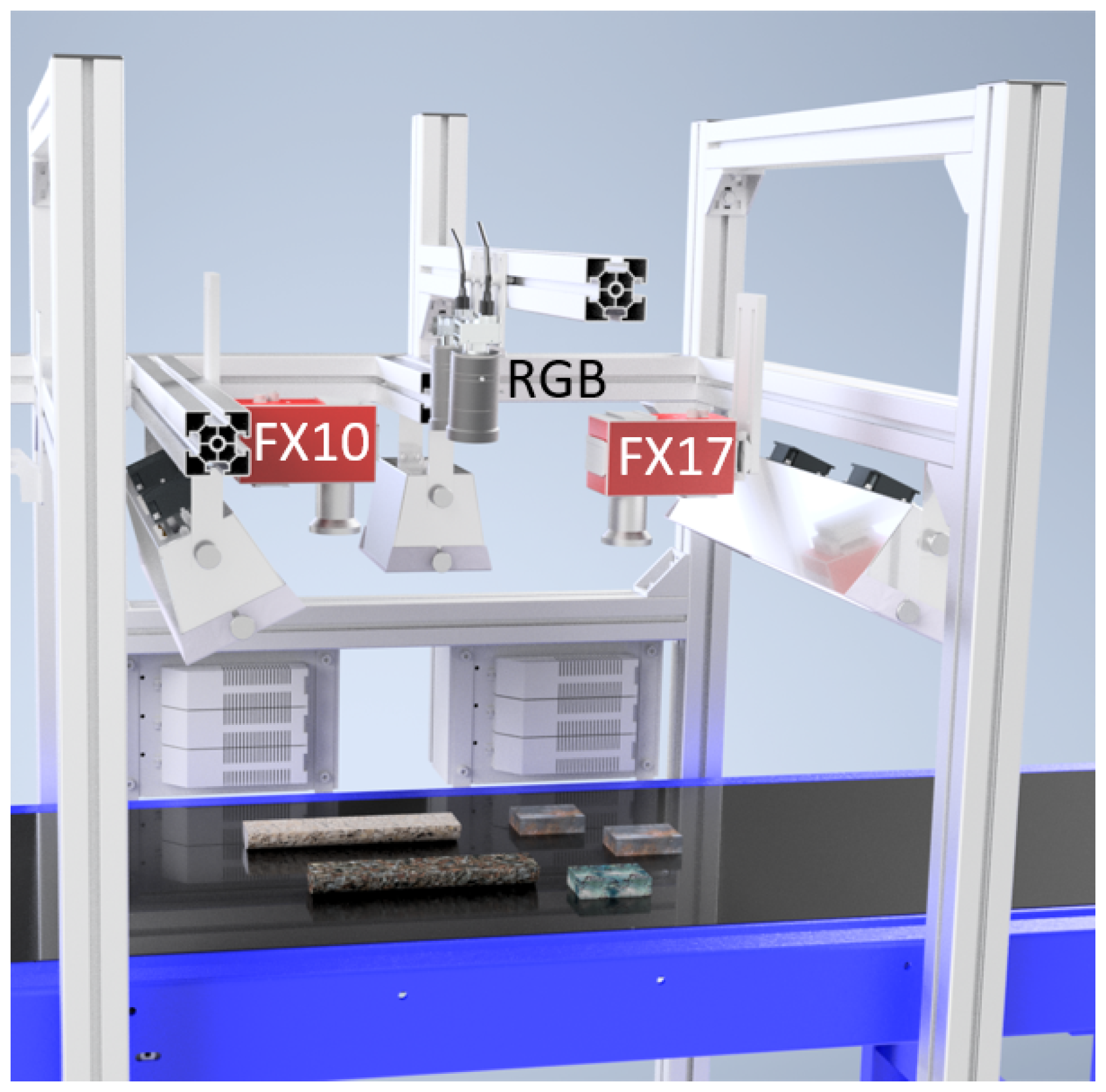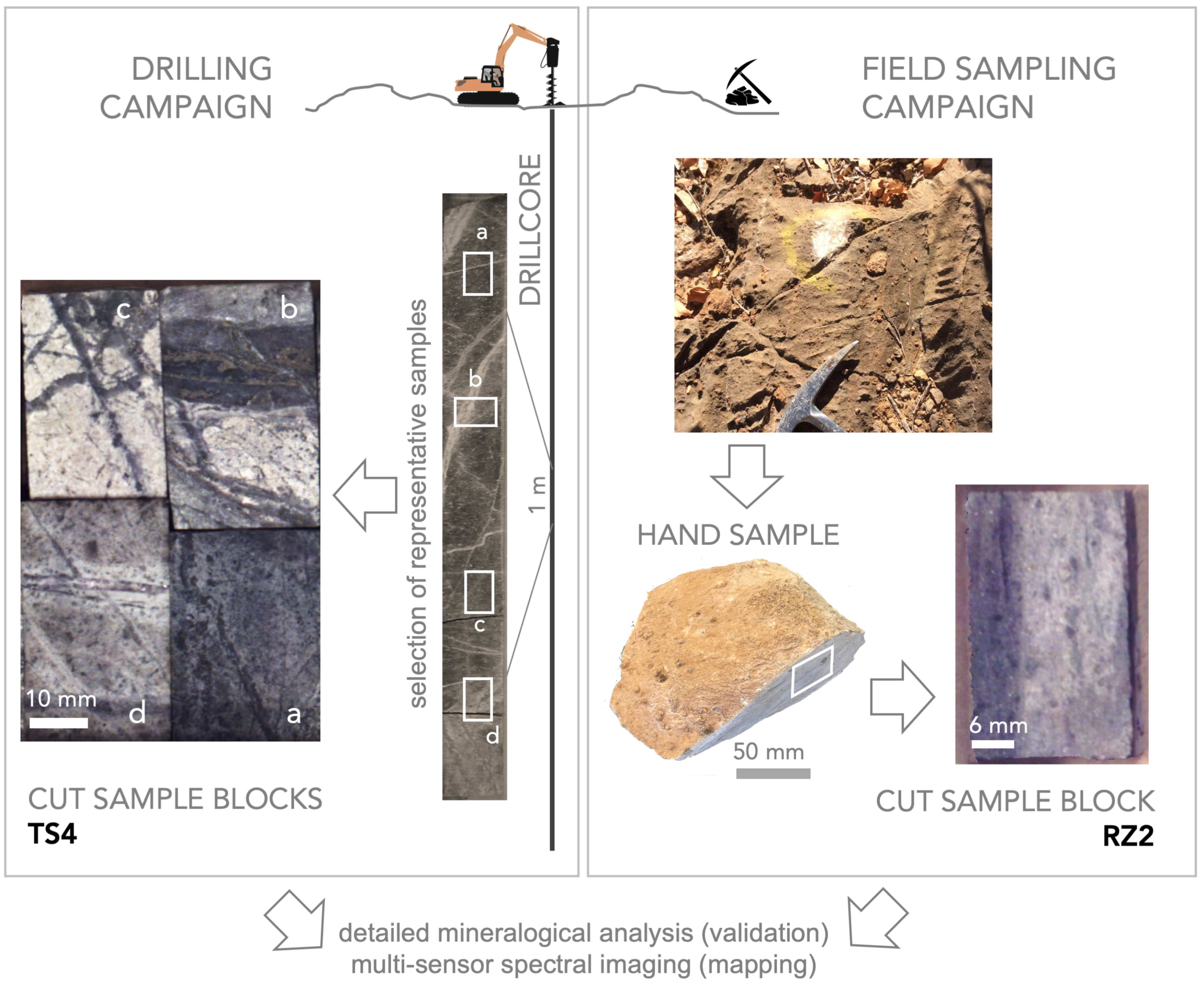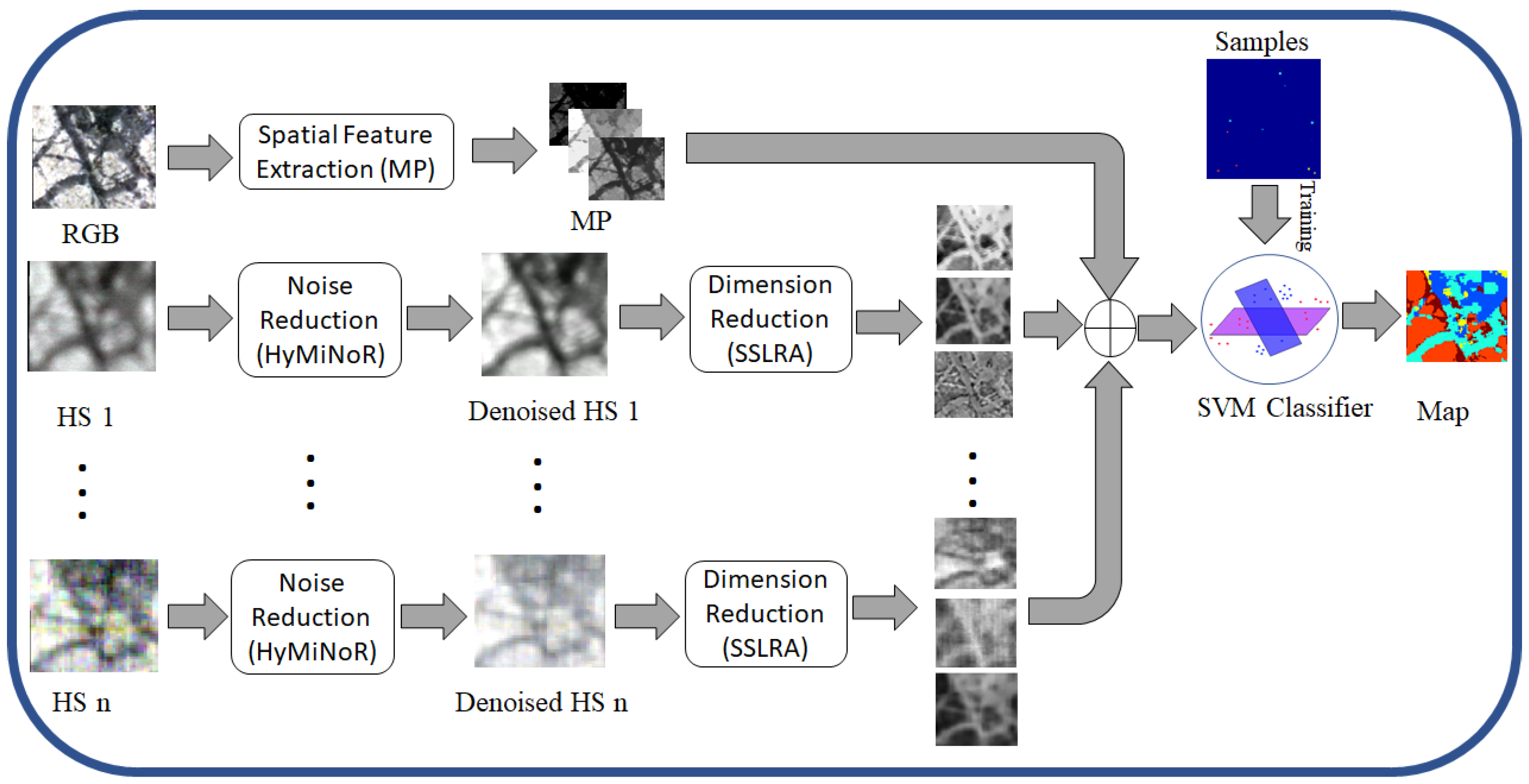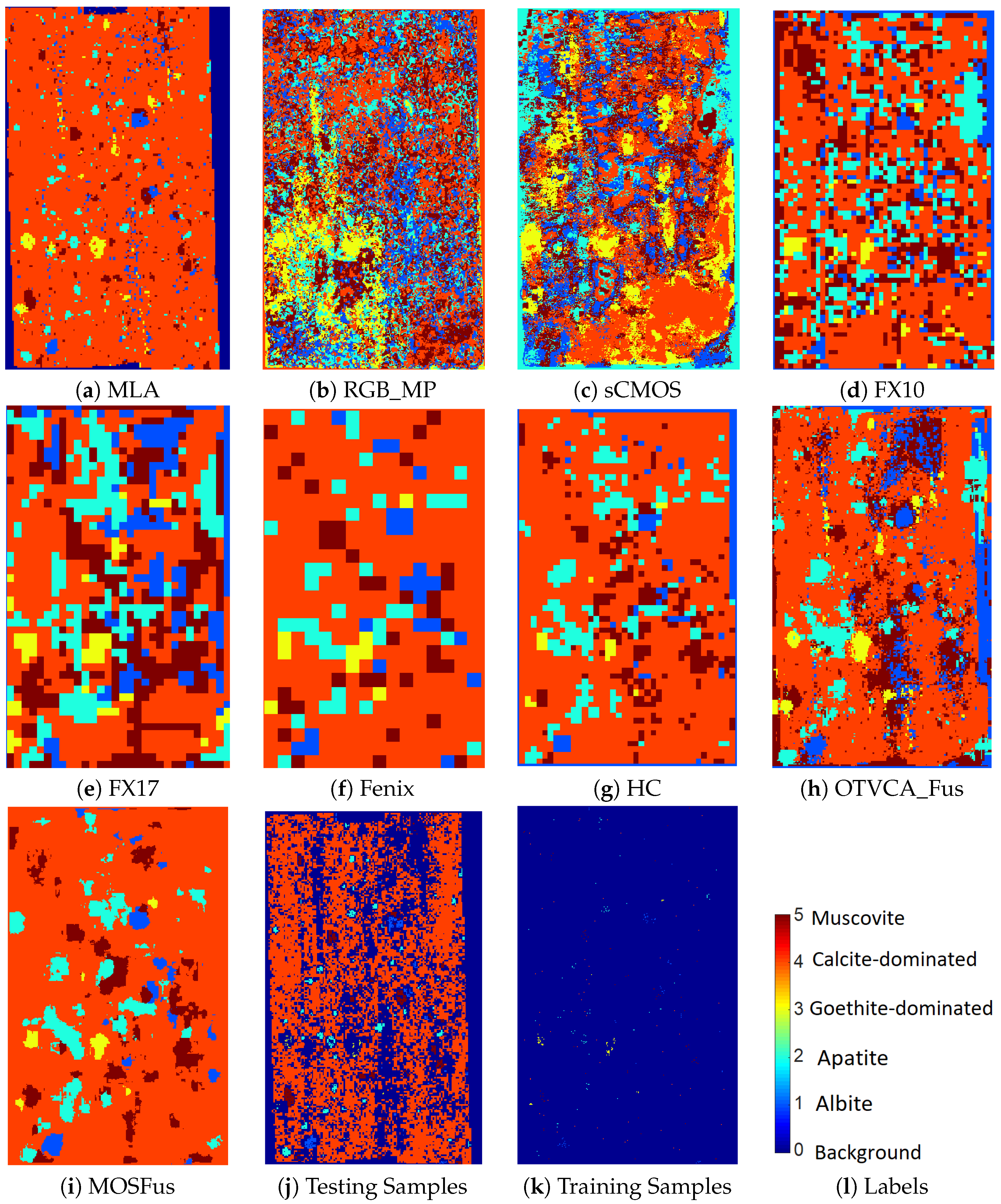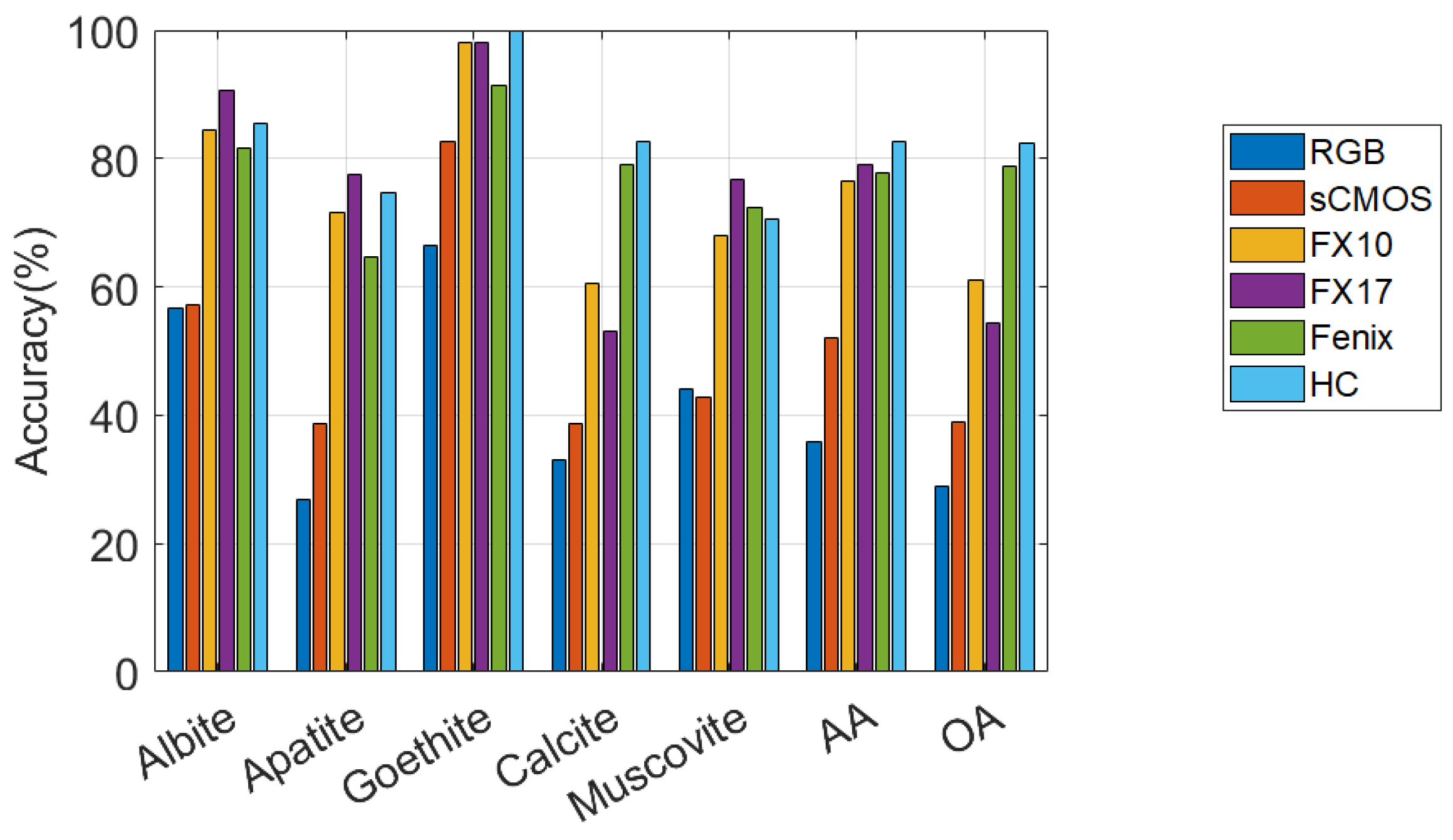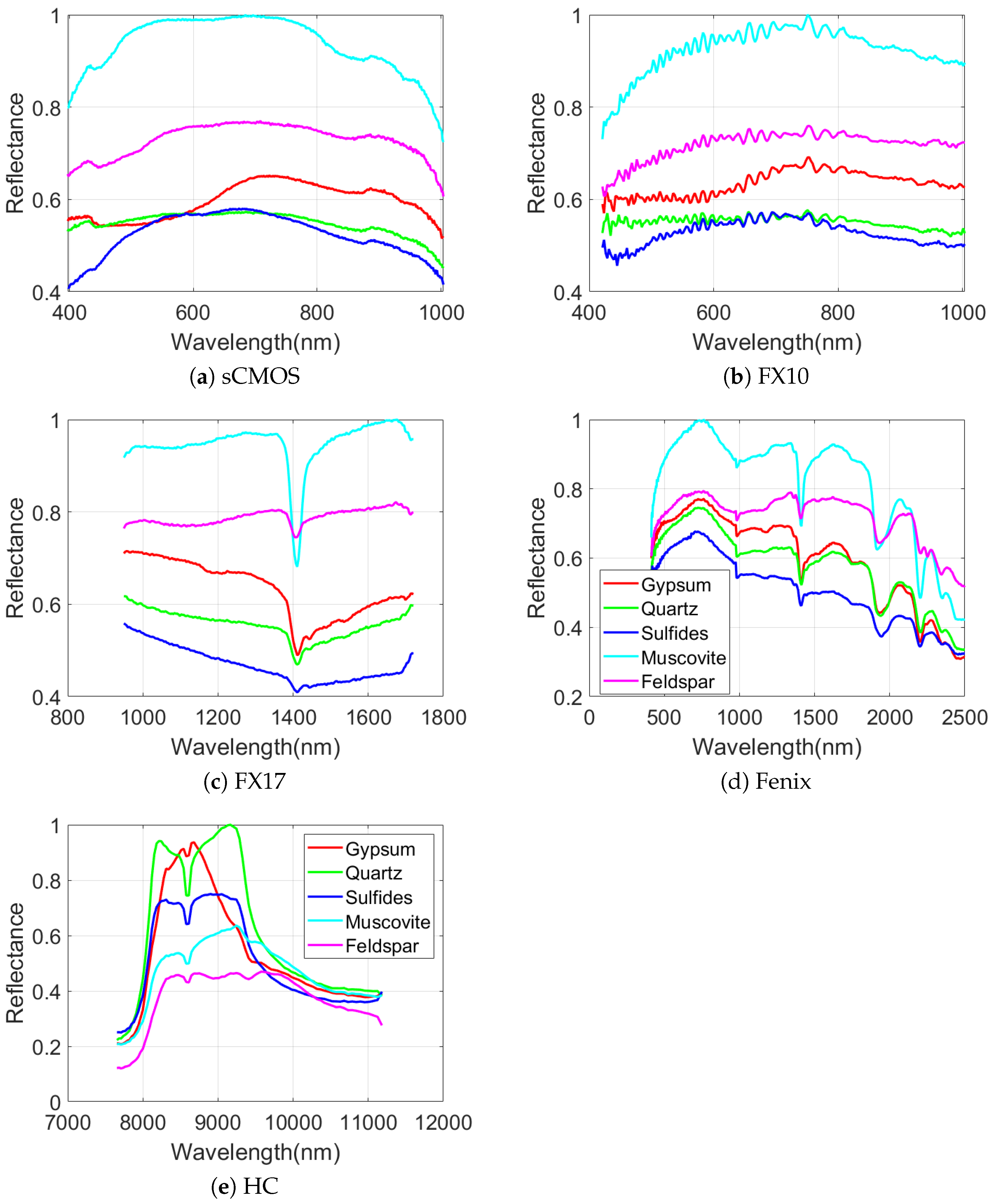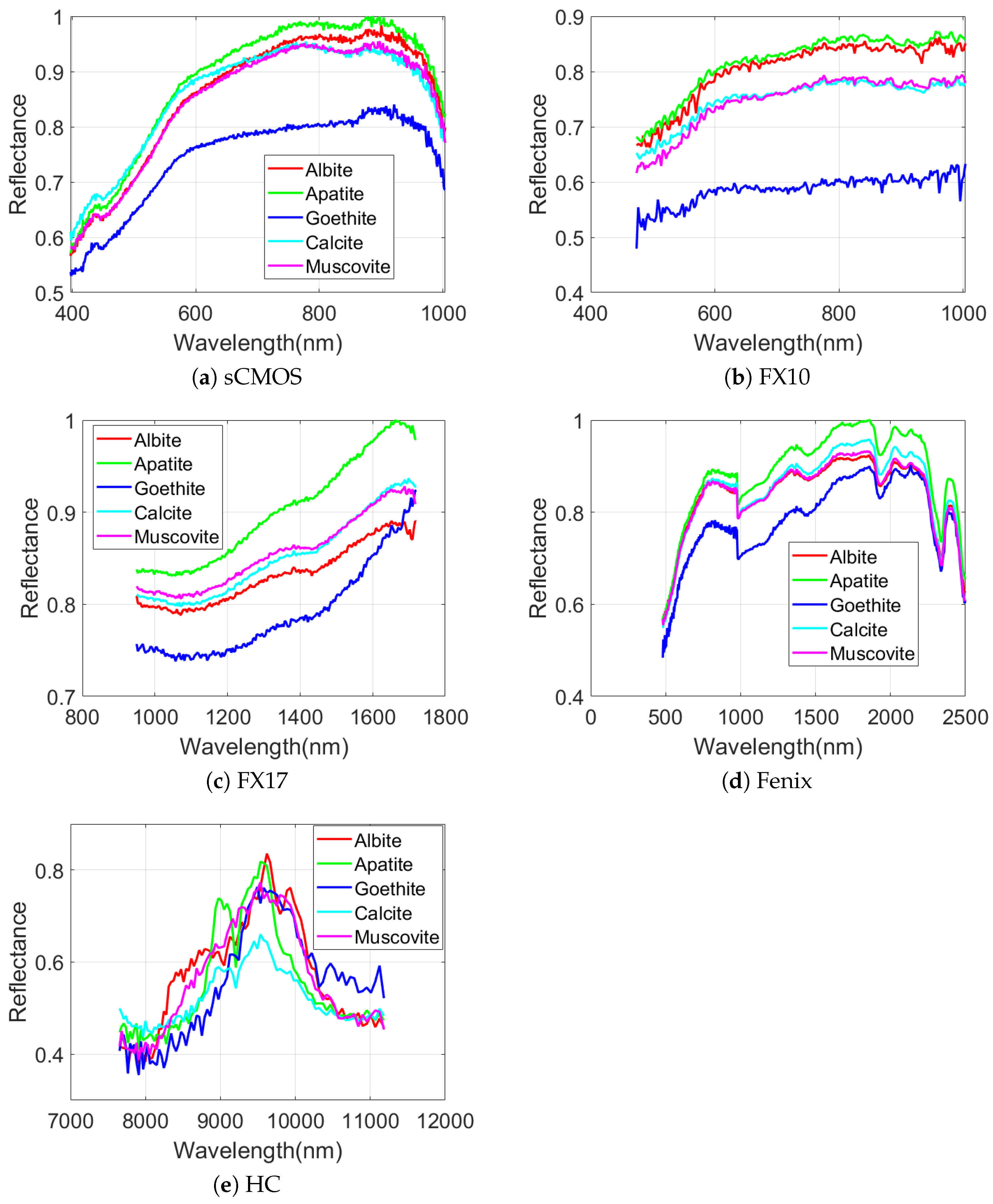1. Introduction
Mineral mapping constitutes an important tool in many geological applications and related industry fields. Mineral exploration and mining are particularly dependent on the accurate localization and characterization of target or indicator minerals at different scales of observation. Extensive sampling campaigns delivering kilometers of drill core or remote sensing data and minerals, often indistinguishable by eye, are only two of the logistical and technical challenges of traditional approaches. Automated, fast, and non-invasive imaging techniques form the forefront of today’s developments to support geologists with this arduous task.
Reflectance spectroscopy allows the rapid characterization of mineralogical samples by the analysis of reflected light over a specific wavelength range. Hyperspectral images, which are represented by hundreds of spectral channels, can be considered as a stack of several pixel vectors in which each pixel vector represents a spectrum in detail at a range of wavelengths. With the availability of such vast spectral information, hyperspectral images have been used enormously to study the interaction of electromagnetic radiation with an object or mineral of interest [
1].
Hyperspectral data have been widely utilized in a variety of fields, such as remote sensing (earth observation) [
2,
3], food processing and inspection [
4], agriculture and forestry [
5], mineralogy [
6,
7], and medical disease diagnosis [
8]. Along with the aforementioned applications in which hyperspectral imagery plays important roles, such sensors have been used intensively for mineral mapping and raw material characterization [
9,
10,
11]. Satellite and airborne campaigns for large-scale regional mapping [
12] and drillcore scanning for the characterization of underground deposits [
13] are currently the most developed application-oriented fields of hyperspectral data for mineral resources. However, close-range terrestrial [
14] and drone-borne measurements [
15] are emerging and allow spatially and timely detailed mapping of outcrops and mines.
The range of deployed hyperspectral sensors is wide and can be grouped best by mode of acquisition (line-by-line, band-by-band, or snapshot) and spectral range covered. For mineral mapping, the most common spectral regions comprise the visible (VIS), near infrared (NIR), short-wave infrared (SWIR), and long-wave or thermal infrared (LWIR). Each spectral range is sensitive for specific groups of minerals only; e.g., visible-near-infrared (VNIR) is most indicative for iron oxides and rare earth elements, SWIR for alteration minerals, and LWIR for rock-forming minerals [
16]. Spectral imaging sensors usually acquire data only within one or a subset of these spectral ranges, partly due to sensor-technical reasons, and partly to trade a part of the maximum total data volume per time to spatial detail. Commercially available sensors provide variations of this inevitable technical compromise between spatial detail, speed, and covered spectral range. The resulting individual single sensor setup defines (and limits) the number, type, and scale of the respective detectable minerals. For example, the acquisition of spectrally well-resolved data over a broader spectral range is usually accompanied by a coarse spatial resolution and slow acquisition time and vice versa. The combined interpretation of several sensor outputs provides a promising workaround to extend the detection capabilities of a single sensor, thereby returning a larger number of detectable minerals in more detail. Sensor-specific variations in spatial resolution, however, provide not only a challenge for data alignment, but also result in different mineral mixtures to be represented by one pixel. In a previous publication [
17], we approached this challenge by classifying meaningful mixed mineralogical domains instead of using a conventional, direct mineral mapping approach. This allowed us to include spectrally inactive minerals into the classification process and to map domains of interest which are not characterized by one specific mineral, but by an indicative mineral mixture. In this framework, we could demonstrate a clear increase of accuracy of mineral domain classification using a multi-sensor setup compared to a single-sensor approach. The underlying pilot processing workflow, however, was still open to improvements.
In this paper, we develop an efficient and effective piece of multisensor technology to fuse diverse optical datasets with different spectral and spatial resolutions and different spectral coverage. The proposed processing chain comprehensively covers all stages, including data acquisition, preprocessing (including data preparation, co-registration, and denoising), feature fusion, and classification. To design the proposed multisensor data fusion approach, the following important factors are investigated: (1) the advancements in the vibrant fields of machine learning and signal processing are brought together to develop a reliable mineral classification and characterization methodology; (2) the advancements of the commercial hyperspectral sensors with diverse spectral coverage and spatial resolution are taken into account for raw material mapping in mineral exploration; and (3) the integrability and added value of multi-sensor datasets are evaluated to obtain an optimal condition for the investigated application. Our captured data represent a set of geological samples and consist of RGB imagery as well as five hyperspectral sensors with unique specifications in terms of sensor design, acquisition speed, spatial resolution, and spectral range. To evaluate our developed methodology, we acquired mineralogical information from scanning electron microscopy-based mineral liberation analyses (MLA) and spectral point measurements covering the complete electromagnetic spectrum in the wavelength range between 0.35 and 15.39
m. The datasets are coregistered using automatically extracted key points. We then perform a hyperspectral mixed Gaussian and sparse noise reduction technique, HyMiNoR [
18], to hierarchically remove different noise types and improve the quality of the input data. Sparse and smooth low-rank analysis (SSLRA) [
19] and orthogonal total variation component analysis (OTVCA) [
20] were recently proposed in the literature (see [
21] for an overview) and regarded as the state-of-the-art unsupervised feature extraction approaches. OTVCA [
20] was used in [
17] for the classification of core samples using a fusion of multisensor images. From here on, the proposed method in [
17] is referred to as OTVCA_Fus. In this paper, SSLRA [
19] is used to extract informative features from the input data which are suitable for the subsequent classification task. The extracted features are then fed as input to a support vector machine classifier with radial basis function kernel (SVM-RBF) [
22] to map mineralogical classes. The performance of this proposed workflow is evaluated using two-sample subsets with different characteristics: (1) with spectrally mixed, but spatially highly unbalanced classes, and (2) with spectrally mixed, but spatially balanced classes. From the methodological point of view, the proposed approach aims to solve the following challenges:
The lack of available training samples to develop a supervised machine learning-based fusion algorithm: This problem is tackled at different stages of the proposed workflow, making it a suitable approach for ill-posed scenarios where there is no balance between the high number of spectral channels and a very limited number of training samples. For example, all preprocessing (including denoising) and feature extraction steps are unsupervised, and therefore, the algorithms do not need any training samples for being trained. In addition, our fusion approach applies both data integration and dimensionality reduction subsequently so as to make a balance between the numbers of extracted features and training samples for the subsequent supervised classification task based on SVM. Furthermore, the SVM classifier, which is the only supervised stage existing in the proposed workflow, can classify multisensor datasets using a limited number of training samples due to its effective theory in designing hyperplanes in feature space to separate between different classes of interest.
Existence of different noise types: The received radiance at hyperspectral sensors is often degraded by several undesired phenomena, such as an acquisition setup and instrumental (sensor) noise, which dramatically downgrade the quality of the input data [
23]. To increase the signal-to-noise ratio of the input data and address the effect of different noise types, we proposed to use HyMiNoR [
18], which is one of the few existing mixed-noise removal approaches recently proposed in the literature.
Hughes phenomenon (the curse of dimensionality) [
24]: The imbalance between the number of spectral channels and available training samples leads to a drop in classification performance, which is inherently caused when the number of spectral channels increases while the number of training samples remains limited. The effect of this issue is magnified when we work with high-dimensional data (e.g., hyperspectral and multisensor data), as is the case in this paper. To address this problem, the approach developed in this paper represents the high-dimensional data input into a lower-dimensional subspace.
The rest of the paper is organized as follows:
Section 2 is devoted to data acquisition and preprocessing.
Section 3 describes, in-depth, the proposed multi-sensor methodology. Experimental results and discussions are detailed in
Section 4 and
Section 5, respectively. Finally, the main concluding remarks are summarized in
Section 6.
6. Conclusions
In this paper, we propose a multi-optical sensor fusion technique (called MOSFus) for the mineral classification and domain mapping. MOSFus contains four main steps: 1—spatial information extraction from RGB, 2—noise reduction, 3—dimensionality reduction, and 4—supervised classification of the reduced spectral and extracted spatial features. The proposed methodology was evaluated based on two datasets from geologically relevant samples. Both datasets used in the study were acquired by a modular multisensor imaging setup. The results confirm that the proposed approach can considerably outperform the classification accuracies of the other fusion techniques and the individual sensors for both datasets. Additionally, it was demonstrated that MOSFus provides better mapping results than the other techniques used in the experiments for both datasets in terms of extracting the mineral spatial structures. Moreover, the experiments showed the advantage of the LWIR spectral range for the classification of target mineral domains existing in the drill core samples compared with the other spectral ranges (i.e., VNIR and SWIR). Many parts of the proposed framework (e.g., preprocessing, denoising, morphological profiles, and feature extraction-based multisensor data fusion) are unsupervised and can easily be applied to a new sample. The classification step using SVM is, however, supervised and it demands training data to define classification boundaries in the feature space to categorize different classes of interest. This means that if the new sample contains different classes than those used to trained the classifier, this method cannot be directly applied to the new sample. As a result, if the samples contain similar classes this method will be applicable to the new sample. On the other hand, this method can be applied on any geological sample having training sets.
